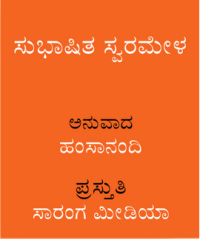Today is 9/26/2014 , the third day of Navaratri. In the posts I made on day 1 and day 2, I wrote about compositions of Syama Sastry and Muttuswamy Dikshita. Today, I am going to write about a composition of Tyagaraja, who together with the before mentioned two composers is generally referred to as the “Trinity” composers in Karnataka Sangeeta. Incidentally, all these there composers were born in the town of Tiruvaroor, in Tamil Nadu.
Tyagaraja spent most of his lifetime in a town called Tiruvaiyyaru on the banks of river Kaveri. He has composed about 800 compositions. His compositions were popularized by his disciples and his compositions have become the mainstay for any concert in Karnataka sangeetha. Since has a large variety of compositions, it would be quite easy to even have a concert
exclusively of Tyagaraja compositions.
When Tyagaraja visited other places of pilgrimage, he often sang on the presiding deities in those places. When he visited his student Patnam Subramanya Iyer at Chenna Pattanam (now Chennai), he also visited some famous temples around there. One such was the Tripura Sundari temple at Tiruvottriyur, now in the northern part of the city.In that temple he composed five compositions on that deity, which have come to be known as Tiruvottriyur pancharatna. Among these, the composition Darini Telusukonti in raga Shuddha Saveri is well known for the intricate sangatis.
That was the time British had a strong presence in Chennai. If at all one good thing happened due to the British, it was the introduction of Violin into Indian music. Muttuswamy Dikshita’s family was associated with a wealthy man called Chinnaswamy Mudaliyar, who was a translator to the British at Fort St George. It was there Baluswamy Dikshita, younger brother of Muttuswamy Dikshita witnessed the band performances of British army and thereby tried to use the Violin to play Indian classical music. As they often say the rest is history – Violin has become an integral part of Karnataka sangeeta both as a solo instrument and as an accompaniment.
Although instruments such as Dhaurveena had existed in the past,which resembled the violin in the fact that they were played using a bow, they were not in practice in the 18th century and thus we have to be thankful for the British army musicians who were instrumental in creating the interest among Indian musicians of that age to experiment with this new instrument!
Now to end this post, listen to a rendition of Darini Telusukonti, on the violin by a young artist from Bengaluru, Apoorva Krishna:
Happy listening!
-neelanjana



5 comments
Comments feed for this article
ಸೆಪ್ಟೆಂಬರ್ 27, 2014 at 3:52 ಅಪರಾಹ್ನ
Nine Nights: Day 4 | ಅಲ್ಲಿದೆ ನಮ್ಮ ಮನೆ
[…] of this Navaratri, I wrote about a music composition of Syama Sastry, Muttuswamy Dikshita and Tyagaraja, who are popularly called the Trinity of Karnataka Sangeeta and then shared with you links for […]
LikeLike
ಸೆಪ್ಟೆಂಬರ್ 28, 2014 at 11:28 ಅಪರಾಹ್ನ
Nine Nights: Day 5 | ಅಲ್ಲಿದೆ ನಮ್ಮ ಮನೆ
[…] Dikshita was the first major composer to use this raga. There is a disputed composition of Tyagaraja in this raga as well. Muttaiah Bhagavatar’s Sudhamayi Sudhanidhi remains one of the very […]
LikeLike
ಸೆಪ್ಟೆಂಬರ್ 29, 2014 at 3:16 ಅಪರಾಹ್ನ
Nine Nights: Day 6 | ಅಲ್ಲಿದೆ ನಮ್ಮ ಮನೆ
[…] from the town of Lalgudi. This town , downstream on the Kaveri river, on which Tiruvaiyyaru where Tyagaraja lived stands has a temple dedicated to Saptarshishwara & his consort Srimathi ( a form of […]
LikeLike
ಸೆಪ್ಟೆಂಬರ್ 30, 2014 at 12:53 ಅಪರಾಹ್ನ
Nine Nights: Day 7 | ಅಲ್ಲಿದೆ ನಮ್ಮ ಮನೆ
[…] Muttuswamy Dikshita composed in all the 72 mELa rAgas postulated as possible by Venkatamakhi. Tyagaraja composed in most of these 72, and he also came up with some more with some permutation and […]
LikeLike
ಅಕ್ಟೋಬರ್ 3, 2014 at 12:52 ಅಪರಾಹ್ನ
Nine Nights: Day 10 | ಅಲ್ಲಿದೆ ನಮ್ಮ ಮನೆ
[…] the 20th century. He composed more than 300 compositions – most of them in Samskrta and Telugu. He belongs to the musical tradition of Tyagaraja. Since Vausdevacharya’s compositions are very much on Tyagaraja’s lines, he is often called […]
LikeLike